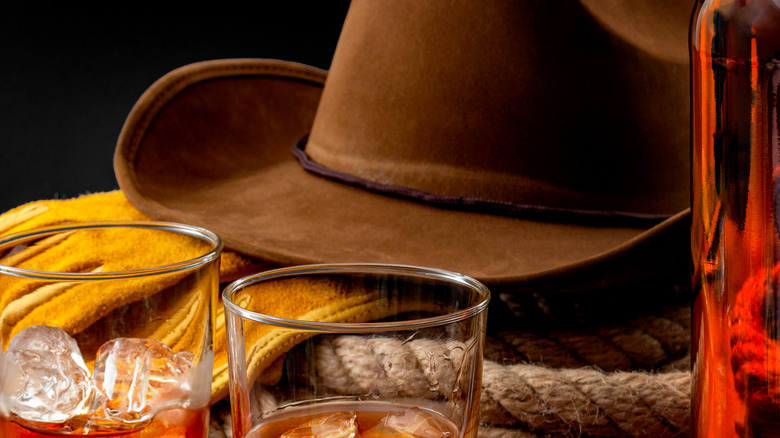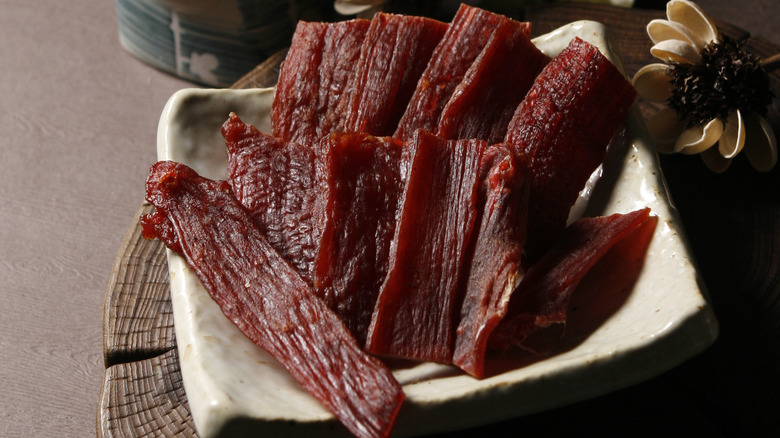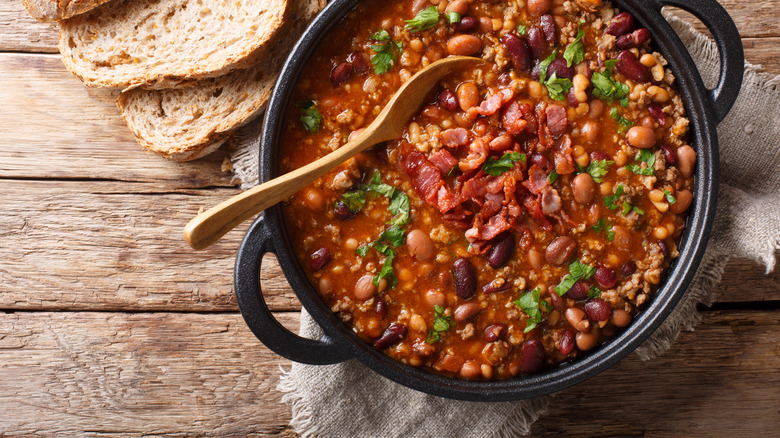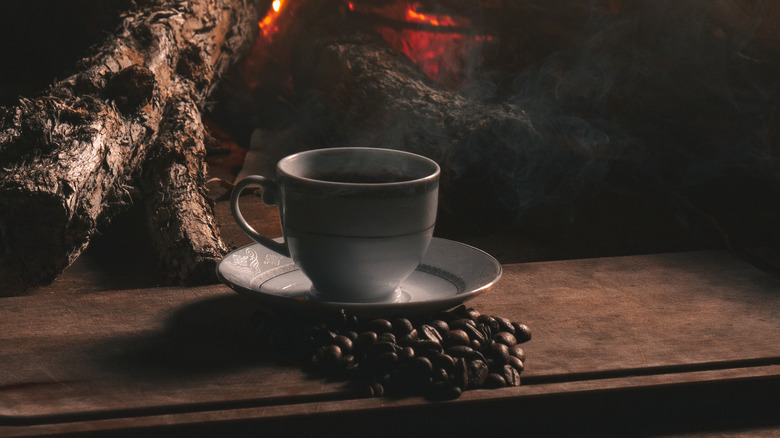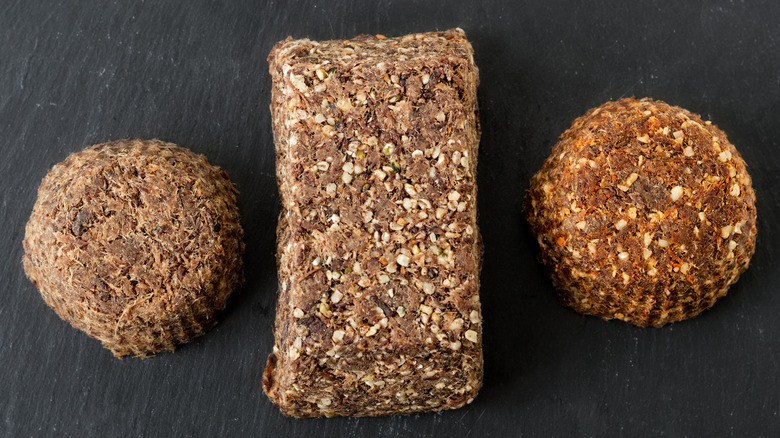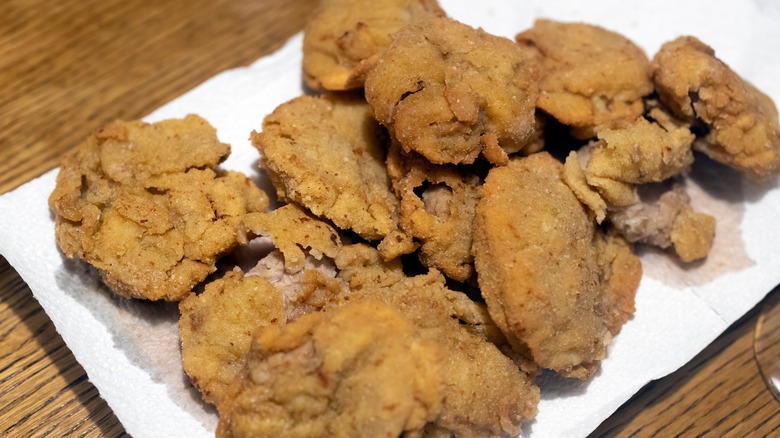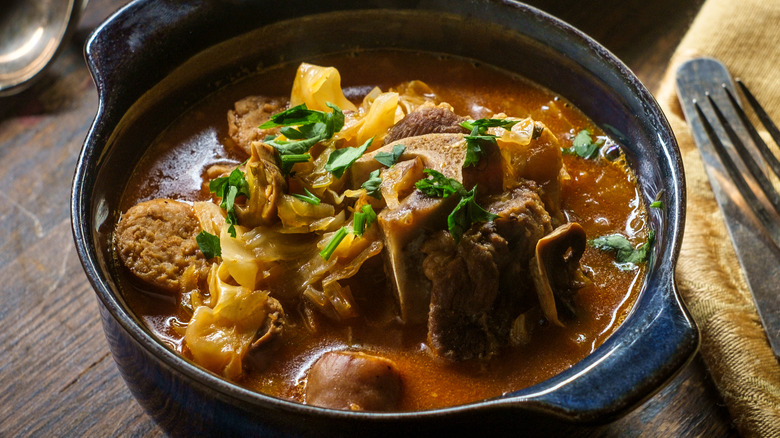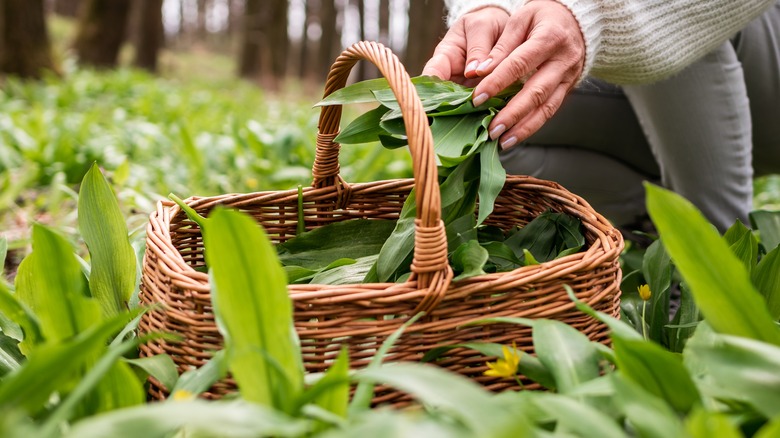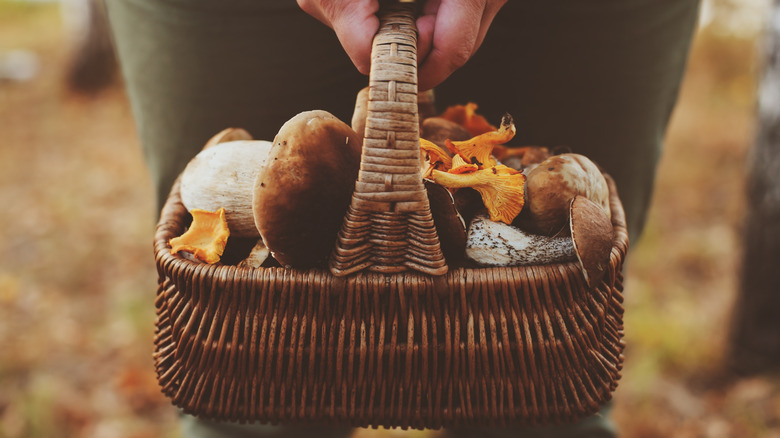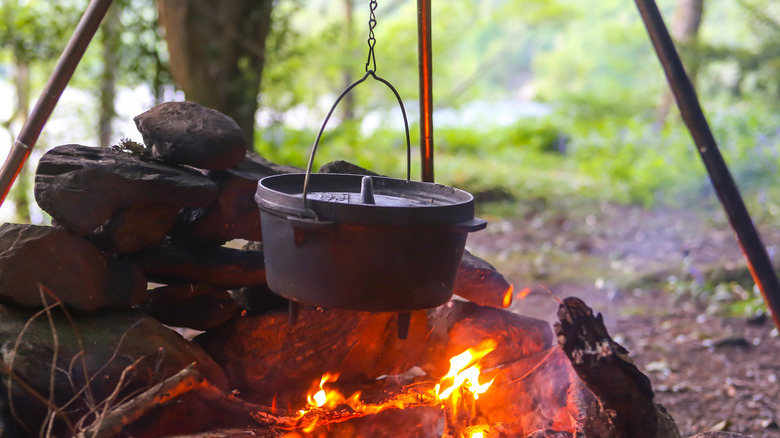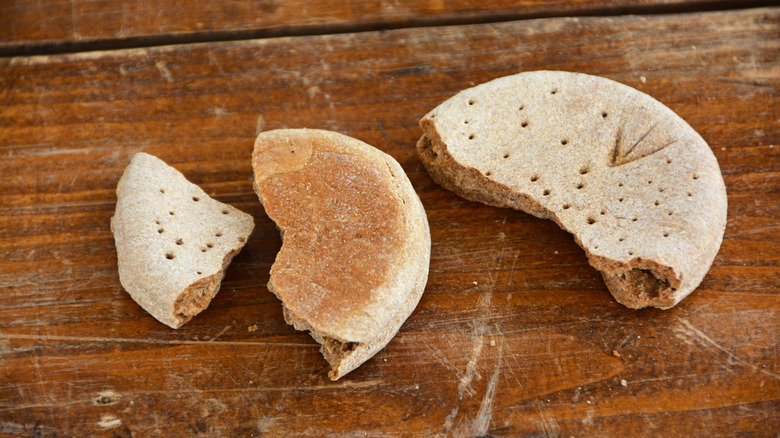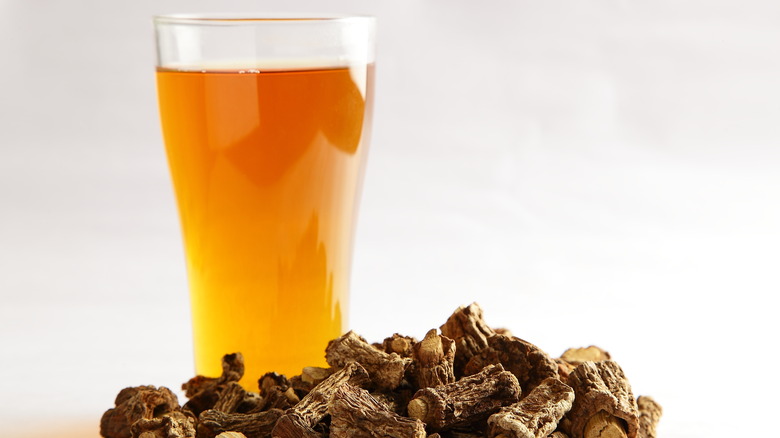Foods From The Old West That Need To Make A Comeback
Cowboys in the Old West worked up voracious appetites. It took a lot of calories to sustain their long days of grueling physical labor, especially on long cattle drives. So it's no wonder that cowboys not only relished their meals at the end of a day, but treated them as nearly sacred.
Per Legends of America, cowboys knew to treat Cookie, the chuckwagon cook, with respect and never interfere with his work — stealing bites between meals or messing with his equipment were big no-nos. And while cowboys ate with their hands while sitting on the ground, there was still a strict code of etiquette: Clean your plate, line up immediately when the cook announces the meal, and to avoid getting dust into the food, no running or saddling a horse near the chuck wagon.
And contrary to popular belief, cowboys didn't just eat beans. Nor did they regularly feast on steaks. "Ranchers often frowned on the idea of cowboys eating beef, in effect consuming their profit," Elizabeth Nelson, associate professor of history at University of Nevada, Las Vegas, told Mashed. But depending on the skills of the cook and the resources available, cowboy cuisine could be surprisingly varied. It wasn't fancy or luxurious — it was food made under harsh conditions to nourish people working under harsh conditions. And sometimes, that's exactly what you want to eat. Here are some dishes from the Old West that deserve a place on our modern tables.
Beef jerky
Food on cattle drives in the Old West had to meet a number of practical criteria. Since refrigeration wasn't an option, anything carried along had to be non-perishable, and since space was limited, it would have ideally been compact and easy to carry. And while these constraints sometimes forced cowboys to settle for less-than-appetizing fare (such as hardtack, rock-hard, often insect-infested crackers that had to be thoroughly soaked in coffee or soup to be edible, according to Bushcraft Buddy), flavor was still a concern — according to History Hit, a chuckwagon cook with a good reputation could be a powerful recruiting tool for ranchers looking for help.
Among the historic foods that ticked all the boxes was smoked beef jerky. Per People's Choice Beef Jerky, cowboys made their own jerky from either beef or from game such as elk, deer, or bison. Theirs wasn't a refined version — it was tougher, dryer, and chewier than most modern jerky — but it was flavorful and a good source of protein. And modern snackers should embrace it for similar reasons: It's an easy-to-carry treat for long hikes or camping trips, and depending on the version you choose, a perfect high-protein, paleo-friendly snack option, per Prevail.
Stewed beans
Stewed beans are another old-school food associated with Old West cowboy culture. But according to Legends of America, they weren't as central a part of the cowboy diet as popularly depicted: While dried beans were a standard part of the chuck wagon pantry because they are non-perishable and lightweight, rehydrating them and cooking them was a long process, and thus not always practical for busy cook at the end of a long day.
Still, they were enjoyed by cowboys from time to time. According to food scientist and chef Michael Murdy, one popular preparation today's diners would enjoy is beans cooked with bacon. "Pinto beans and bacon are cooked together in a Dutch oven over an open flame or a campfire, creating a savory flavor from the bacon and an earthy note from the beans," Murdy explained to Mashed. "The high heat of the campfire adds a unique smoky flavor to the meal. It is easy to make, and the ingredients are easy to find, making it great for outdoor cookouts or a spontaneous camping trip."
Cowboy coffee
Cowboys in the Old West loved their caffeine — and they got their fix from cowboy coffee, a rustic concoction of coarsely ground coffee boiled in a kettle over an open fire. But if you're a serious coffee aficionado raised on the admonition to never let coffee boil (even Starbucks, known for its aggressively roasty brews, advises against the practice), hear us out.
According to longtime cowboy cook Kent Rollins, cowboy coffee, if made correctly, is a treat. "Cowboy coffee, when it is made right, is probably the smoothest coffee in the world. I have had so many folks come up to me and tell me they can't drink coffee because it upsets their stomach or gives them acid reflux. But, when you boil coffee correctly, it takes the bitterness out and boils the acid out of the bean," he said.
So if you love coffee but don't feel like splurging on specialized equipment — or find yourself on a camping trip or in an AirBnB with a non-functioning coffee maker — give cowboy coffee a chance. If you're still worried about possible bitterness, try this trick from America's Test Kitchen and put clean eggshells in with your coffee before boiling it.
Pemmican
In recent years, there's been a fascination in the food world with ancient foodstuffs. Long-forgotten grains popular millennia ago, such as einkorn and spelt, have started making frequent appearances in artisanal baked goods and other dishes (per Clean Technica), and even one of today's trendiest diets, the paleo diet, is meant to replicate ancient, and presumably more healthful, eating habits, according to Nutrition Today.
Among the foods with ancient roots enjoyed by cowboys in the American West was pemmican, portable bars made from rendered fat, shredded or pulverized dried meat (traditionally, game such as venison), and sometimes berries, according to Britannica. It was introduced to cowboys by Native Americans, per History Hit. Cowboys appreciated it because it was portable, non-perishable, and provided plenty of calories and protein in a small package.
It's since gained a reputation as a superfood. According to Mark's Daily Apple, early 20th-century anthropologist Vihljamur Stefansson travelled with an Inuit group in Alaska and lived for weeks at a time on only pemmican and water. He later felt he'd never felt healthier. So if you're looking to experience a bit of ancient history while getting a serious protein fix, look no further.
Rocky Mountain oysters
Another ancient food trend, once inelegantly called "don't waste meat," has been revived and rebranded with a romantic new name: nose-to-tail eating. As the name implies, this refers to the practice of eating every potentially edible part of a butchered animal, from the nose to the tail, according to Clean Eating. Not only does this allow daring diners to enjoy a richer range of flavor experiences, but it's also less wasteful and more environmentally friendly (since the resources used to raise the animal are actually providing more food) as well as budget-friendly (since traditionally overlooked cuts, such as tripe and pigs' feet, can be had inexpensively).
Cowboy cooks, who frequently hunted and regularly saw cattle being butchered, were among those who followed the principles of nose-to-tail eating. Meat was precious to hungry cowboys, and not a bit of it was wasted. For instance, among the cowboys' unenviable responsibilities (per Gastro Obscura) was castrating young bulls, both for contraceptive purposes and to curb their aggression. This left cowboys with large quantities of detached testicles, so they did what cowboys always did when encountering a free source of meat: They ate them. The standard treatment was to batter and deep-fry them (the larger ones would be sliced first). Today, the unusual treats, nicknamed "Rocky Mountain oysters" remain a regional favorite in the American west, and are worth checking out if you love adventure and hate food waste.
Rascal stew
Rascal stew (also called son of a gun stew, along with other less family-friendly names) was another reflection of the nose-to-tail ethos in action on Old West cattle trails. The stew, composed of a variety of organ meats that could include the heart, brains, liver, shortbreads (thymus), and marrow gut (per Art of Manliness), was not only a way to ensure not one bit of a slaughtered beast was wasted, but also a dish relished by cowboys.
"Organ meat was considered a special treat," said Elizabeth Nelson, associate professor of history at University of Nevada, Las Vegas. Nelson explained that fresh meat was often hard to come by on the cattle trail (since it couldn't be stored unrefrigerated and eating the rancher's inventory was discouraged), so stews were more often made with preserved or dried meats such as salt pork. So on the infrequent occasions fresh beef was available, every bit of it was used and enjoyed.
Locally foraged greens and herbs
Even the most resourceful cowboy cooks only had limited space for provisions, and the few provisions they could bring along had to have a long shelf life. "Common provisions were flour, salt pork or bacon, dried meat, beans, cornmeal, coffee, molasses, vinegar, salt, beef suet or lard, and dried fruit," explained Elizabeth Nelson, associate professor of history at University of Nevada, Las Vegas.
But while an experienced cook could easily whip up a hearty meal with just these ingredients, it would still end up a bit beige, even for a macho gang of cowboys. To break up the monotony and add some color and novel flavor to their meals, cowboys sometimes foraged for wild greens and herbs, according to Ask a Prepper. And the types of herbs and greens they encountered varied by location: One day, you'd encounter watercress, lamb's quarters, or wild asparagus, while another you might find wild garlic, chicory, or sage.
And while these plants have never gone away, they remain underappreciated by most modern diners — which is too bad. Per Wild Edible, foraged greens are richer in essential minerals and vitamins than commercially grown produce; plus, gathering them is a great way to get in touch with your natural environment. But if you do decide to start foraging, do your homework: Find an experienced forager to show you how to identify edible plants in your area. And if you have any doubt about whether a plant is edible, leave it alone.
Wild mushrooms
Cowboys regularly supplemented the food provided on the chuck wagon by hunting and foraging for wild foodstuffs. And even in the arid west, edible wild mushrooms were available, according to Ask a Prepper. The catch was so were a lot of poisonous wild mushrooms, and telling them apart was no easy feat — sometimes safe and unsafe mushrooms could look dangerously similar. For this reason, many cowboys shied away from all them, figuring life on the open range was dangerous enough as it was.
Still, some cowboys were willing to take that chance. Most who did hedged their bets by limiting their foraging to visually distinctive edible mushrooms without poisonous look-alikes. Among these were morels, blackish mushrooms with tall, lacy caps, and fat puffball mushrooms. Today, morels are a sought-after gourmet treat in farmers' markets on the infrequent occasions they are available, and giant puffballs (which can grow to be the size of soccer balls, according to Forager Chef) grow prolifically and are easy to find in some parts of the country. They also make for good eating: A traditional preparation is to bread and fry them, but they also make great soups and, if sliced and rolled thin, a tasty substitute for lasagna sheets. But whatever mushroom you're foraging, confirm with an expert that it's safe before you heat up your frying pan.
Cowboy stew
Another challenge chuckwagon cooks faced was limited cooking supplies. "The challenges of cooking over an open fire with simple cooking utensils limited the variety of what cowboys ate," Elizabeth Nelson, associate professor of history at University of Nevada, Las Vegas, told Mashed. "Most meals were cooked in a Dutch oven or a spider (a covered skillet with cast iron legs that could be set in the coals) or in a pot hung on an iron bar suspended over the fire."
This meant that stews were a common menu item. And it's likely there were as many variations of cowboy stew as there were cowboy cooks. "There really isn't much in the way of recorded recipes for cowboy food — that just isn't how it was done," Nelson said. Still, a common goal of cowboy stew was to render whatever meat it contained appetizingly tender. According to George Ranch Historical Park, in the days before cattle were cross-bred, Texas cattle tended to be lean, which meant it was at its best when slowly stewed at a low temperature. And according to food scientist Michael Murdy, canned vegetables such as tomatoes and carrots were another frequent component of cowboy stews. So if you want to save money by cooking with tougher pieces of meat but don't feel like researching complicated recipes, channel your inner Cookie and invent a stew of your own using whatever vegetables and seasonings you have around. After all, that's how it was done on the trail.
Hardtack
Okay, we're not going to lie: Unless your culinary tastes run towards things that are bland, dry, and hard enough to break a tooth, hardtack is unlikely to become your favorite. But if you're a backpacker, camper, or live in an area where an emergency earthquake or hurricane survival kit with a good supply of non-perishable food is a standard part of life, hardtack should be your friend, as it was to generations of sailors and cowboys in need of a durable food source (per the Texas Historical Commission). As its name implies, these thick crackers — typically made from just flour, water, and salt (per the Texas Historical Commission) — are hard. REALLY hard.
So why should you eat these miserable cracker-like things, and how? You can think of hardtack as akin to dry pasta: You wouldn't eat it as is, but softened and flavored with other foods, it's filling and comforting. Cowboys back in the day soaked hardtack in coffee or soup or other hot, wet foods to soften it enough to become agreeable to eat, and sometimes even fried the softened pieces. And if you're an avid camper or backpacker who regularly relies on freeze-dried, cook-in-a-bag meals but finds they're not quite enough to fill you up, YouTuber doitreteakk suggests breaking some hardtack into the bag before adding in the hot water. Wait the recommended time for everything to reheat and rehydrate, and you'll have a meal that will fill you up quickly.
Sarsaparilla
Chances are, the only reason you even know sarsaparilla exists is from watching old cowboy movies: In a typical scene, the hero strolls up to the bar and boldly orders a sarsaparilla, to the mockery of his whiskey-drinking (and less-than-honorable) peers. But in the real Old West, sarsaparilla was more than just a punchline. Per cowboy historian Chip Schweiger, the soft drink was indeed relished by cowboys, as much for its purported health benefits as its taste. The drink, made from a wild North American relative of ginseng (per the South Florida Sun-Sentinel), was first developed in the 16th century by Spanish soldiers who considered it a cure for syphilis, and 19th century Americans attributed any number of curative properties to the drink.
So how does it taste? According to the Sun-Sentinel, it tastes a bit like root beer. Indeed, sarsaparilla was one of the key ingredients in some early formulations of root beer, along with other herbs including wintergreen. According to Bundaberg, the plant extract used in sarsaparilla has a slightly bitter flavor, which drink manufacturers counterbalance with sweeter ingredients such as licorice. If you like root beer but wish the flavor could be cranked up a notch, sarsaparilla could be the drink for you — per Miss Vickie, it has a root-beer like flavor, only more intense with a slight bitter note. It's also still said to have health benefits, including alleviating pain and gastric distress.
